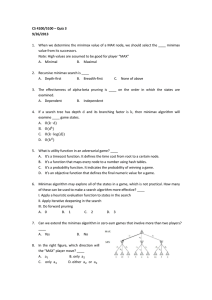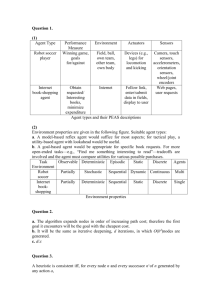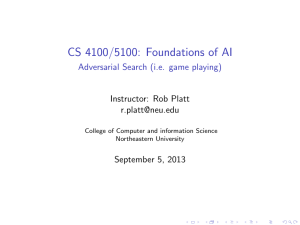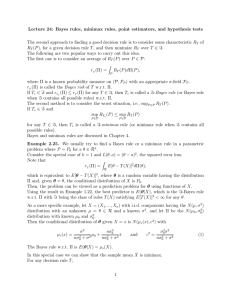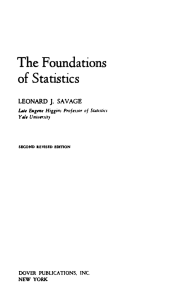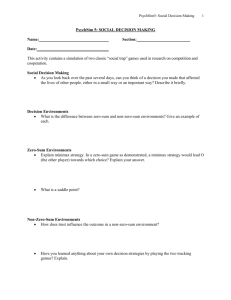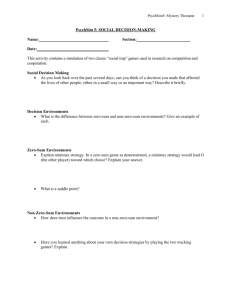IEOR 151 – Lecture 4 Composite Minimax 1
advertisement
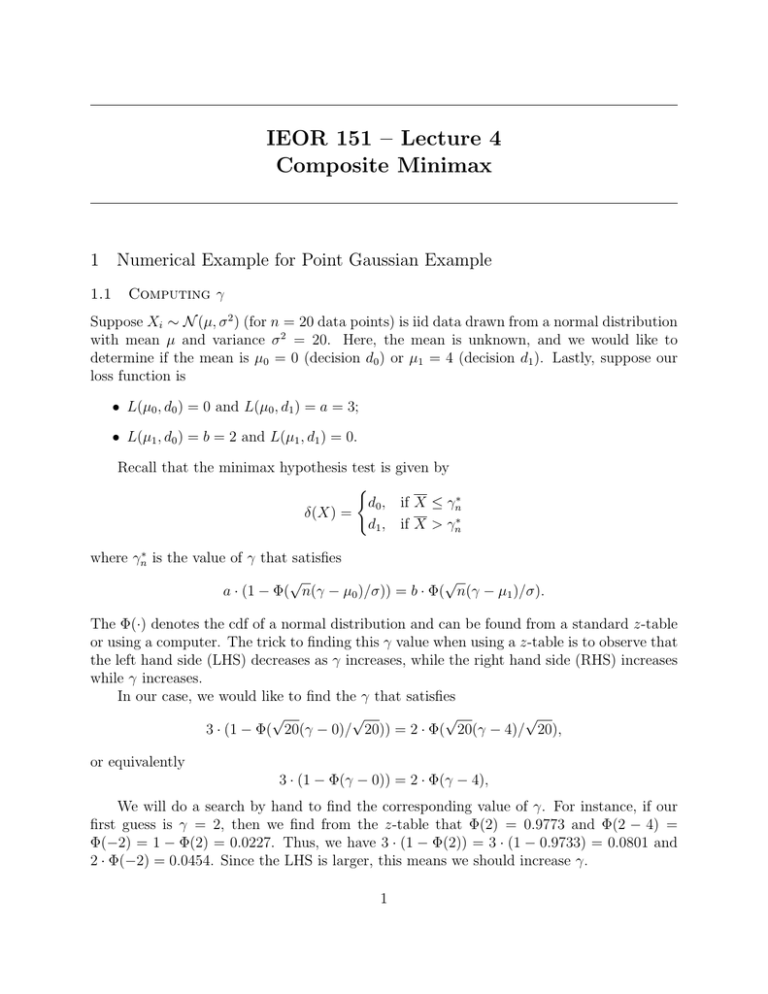
IEOR 151 – Lecture 4 Composite Minimax 1 Numerical Example for Point Gaussian Example 1.1 Computing γ Suppose Xi ∼ N (µ, σ 2 ) (for n = 20 data points) is iid data drawn from a normal distribution with mean µ and variance σ 2 = 20. Here, the mean is unknown, and we would like to determine if the mean is µ0 = 0 (decision d0 ) or µ1 = 4 (decision d1 ). Lastly, suppose our loss function is • L(µ0 , d0 ) = 0 and L(µ0 , d1 ) = a = 3; • L(µ1 , d0 ) = b = 2 and L(µ1 , d1 ) = 0. Recall that the minimax hypothesis test is given by ( d0 , if X ≤ γn∗ δ(X) = d1 , if X > γn∗ where γn∗ is the value of γ that satisfies √ √ a · (1 − Φ( n(γ − µ0 )/σ)) = b · Φ( n(γ − µ1 )/σ). The Φ(·) denotes the cdf of a normal distribution and can be found from a standard z-table or using a computer. The trick to finding this γ value when using a z-table is to observe that the left hand side (LHS) decreases as γ increases, while the right hand side (RHS) increases while γ increases. In our case, we would like to find the γ that satisfies √ √ √ √ 3 · (1 − Φ( 20(γ − 0)/ 20)) = 2 · Φ( 20(γ − 4)/ 20), or equivalently 3 · (1 − Φ(γ − 0)) = 2 · Φ(γ − 4), We will do a search by hand to find the corresponding value of γ. For instance, if our first guess is γ = 2, then we find from the z-table that Φ(2) = 0.9773 and Φ(2 − 4) = Φ(−2) = 1 − Φ(2) = 0.0227. Thus, we have 3 · (1 − Φ(2)) = 3 · (1 − 0.9733) = 0.0801 and 2 · Φ(−2) = 0.0454. Since the LHS is larger, this means we should increase γ. 1 Now suppose our second guess is γ = 2.5. Then, Φ(2.5) = 0.9938 and Φ(2.5 − 4) = Φ(−1.5) = 1 − Φ(1.5) = 1 − 0.9332. Thus, we have that LHS = 3 · (1 − 0.9938) = 0.0186 and RHS = 2 · (1 − 0.9332) = 0.1336. Now, the RHS is larger and so we should decrease our guess of γ. Since we know that γ = 2 is too small, we could try half-way in between with γ = 2.25. We can summarize the steps We conclude the process when we have sufficient accuracy Step 1 2 3 4 5 6 7 8 γ 2 2.5 2.25 2.13 2.06 2.09 2.07 2.08 LHS 0.0801 0.0186 0.0367 0.0498 0.0591 0.0549 0.0577 0.0563 RHS 0.0454 0.1336 0.0801 0.0615 0.0524 0.0561 0.0536 0.0549 in our computed value of γ. In this case, we know that γ should be between 2.08 and 2.09, and so we set γn∗ = 2.085. Computing γ to more precision would require a computer. 1.2 Differences in γ as n Changes In the above example, we computed γn∗ for a single value of n = 20. A natural question to ask is what happens to γ as n increase. In the table below, the value of γn∗ for different values of n is given. These values were computed using a computer. n 5 10 20 100 200 300 γn∗ 2.2658 2.1536 2.0855 2.0194 2.0099 2.0068 The trend is clear: As n increases, γn∗ is decreasing towards 2. The intuition is that when we have little data, we err on the side of deciding d0 since otherwise we incur a larger loss if we incorrectly decide d1 . As we gather more data, we are more confident that the sample average is close to the true average, and so we can use a less biased threshold. Effectively, with large amounts of data the threshold converges to (µ0 + µ1 )/2. 2 Composite Gaussian Example In our discussion so far, we have considered a situation in which the two hypothesis each represent a distribution with a single mean. However, another class of interesting and more 2 general hypotheses are those in which we would like to discrimination between H0 : µ ≤ µ0 versus H1 : µ > µ0 . And suppose we keep a similar loss function of L(H0 , d0 ) = 0, L(H0 , d1 ) = a, L(H1 , d0 ) = b, and L(H1 , d1 ) = 0. In the minimax framework, this class of hypotheses are not well-posed because the worst case scenario occurs when “nature” selects µ = µ0 , because then it is not possible to distinguish between d0 and d1 . More rigorously, what happens is that the minimax procedure is defined by solving the optimization problem inf sup R(µ, δ). δ(u) µ And nature will choose sup R(µ, δ) = sup a · Pµ (d1 = δ(X))} µ:µ≤µ0 µ:µ≤µ0 = a · Pµ0 (d1 = δ(X))} and sup R(µ, δ) = sup b · Pµ (d0 = δ(X))} µ:µ>µ0 µ:µ>µ0 = b · Pµ0 (d0 = δ(X))}. This last step is subtle: Even though nature is constrained to choose µ > µ0 , it can choose µ to be arbitarily close to µ0 . Thus, in the worst case scenario described by the minimax framework, nature will effectively set µ = µ0 even though we are in the case H1 : µ > µ0 . Because of this pathological behavior, the best we can do with a minimax procedure is to make a purely probabilistic decision: ( d0 , with probability a/(a + b) δ(X) = d1 w.p. b/(a + b) This is not a useful rule for decision making, and so we must consider alternative classes of hypotheses. One interesting class of hypotheses is the following: Suppose X1 , . . . , Xn ∼ N (µ, σ 2 ) is iid data drawn from a normal distribution with mean µ and known variance σ 2 ; here, the mean is unknown. The decision we would like to make is whether the mean is H0 : µ ≤ µ0 or H1 : µ ≥ µ1 . We are indifferent in the case where I : µ ∈ (µ0 , µ1 ). Our loss function also encodes this region of indifference • L(H0 , d0 ) = 0, L(H0 , d1 ) = a; • L(H1 , d0 ) = b, L(H1 , d1 ) = 0; • L(I, d0 ) = 0, L(I, d1 ) = 0. 3 It turns out that this composite hypothesis test has the same minimax procedure as the point hypothesis test. To summarize, we choose γ so that it satisfies √ √ a · (1 − Φ( n(γ − µ0 )/σ)) = b · Φ( n(γ − µ1 )/σ), where Φ(·) is the cdf of a normal distribution. If we call this resulting value γ ∗ , then our decision rule is ( d0 , if X ≤ γ ∗ δ(X) = d1 , if X > γ ∗ Showing that this decision rule is a minimax procedure is beyond the scope of the class. 4
